
The Hofje van Staats is a hofje in Haarlem, Netherlands, on the Jansweg 39, close to the Haarlem railway station.

The Hofje van Staats is a hofje in Haarlem, Netherlands, on the Jansweg 39, close to the Haarlem railway station.



It was built from July 29, 1730, to 1733 from the legacy of the Haarlem thread-seller Ysbrand Staats. He left his entire legacy to the poor, and his brother took charge of building this hofje after he died. The first hofje to be built in the 18th century, the executors visited Alkmaar under the leadership of architect Abraham Kleijn, to visit the "new style hofje" Wildemans. In former times hofjes were built in the back gardens of larger homes of the wealthy donors. In 1730 the new style hofjes were luxurious complexes with fancy gateway buildings directly on the street. The original gateway house of this hofje still stands, but no longer functions as the home of a governing regent, but as a storefront. It is certainly grander than the Wildeman's hofje, but was itself surpassed as the fanciest hofje in Haarlem by the Teylers Hofje.
The hofje was designed to be grand, because it was meant for women of the Dutch Reformed faith, at that time the official faith of the Haarlem council. According to the original hofje rules and regulations, the women eligible to live there were not very poor, because they had to buy their place for 50 florins and bring a long list of possessions with them, including clothing and furnishings. It originally had houses for 29 single elder women, after the renovation in 1990 this was reduced to 20.
The hofje was quite wealthy, and in 1783 celebrated its 50-year jubilee with a glass for the regents engraved with the portrait of Ysbrand Staats. According to the period history of Haarlem by Pieter Langendijk, the hofje had bleaching fields behind the easternmost cottages and a pavilion on the Spaarne river for the ladies to drink tea in. During the French occupation the finances took a turn for the worse and that land was sold. An original drawing of the complete hofje complex from the Jansweg to the Spaarne hangs in the Hofje van Noblet, whose finances are also managed by the same "Foundation for the preservation of the Hofjes Staats and Noblet".
Address: Jansweg 39
| Dutch Rijksmonument 19341 |

The Hofje van Bakenes or Bakenesserkamer is a hofje in Haarlem, Netherlands, located between the Bakenessergracht and the Wijde Appelaarsteeg. In the Middle Ages "kamer" or "room" meant house. Usually the houses within a hofje consisted of just one room.
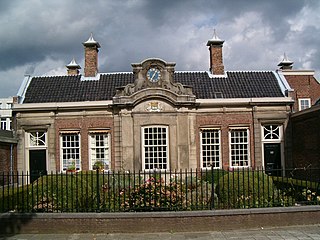
The Hofje van Noblet is a hofje in Haarlem, Netherlands.

The Frans Loenenhofje is a hofje in Haarlem, Netherlands, on the Witte Heren straat.
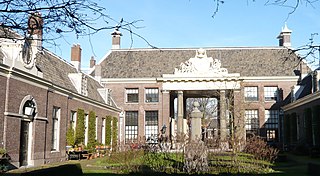
The Teylershofje is a hofje in Haarlem, Netherlands with 24 houses.

Haarlem is one of the cities in the Netherlands that has a number of hofjes. Some of them are still in use with boards of regents. Many of these are members of the Stichting Haarlemse Hofjes. The word 'hofje' just means small garden, because the hofjes are generally small houses grouped around a community kitchen garden with a water pump. Often they were attached to a larger field for bleaching linen or growing orchards, but today those fields have been long used for city expansion and only the central gardens can still be seen.
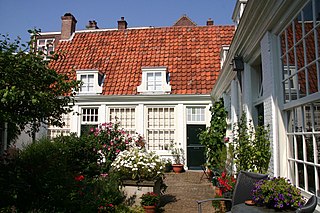
Hofje van Guurtje de Waal is a hofje in Haarlem, Netherlands.
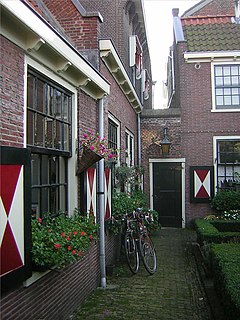
The Bruiningshofje is a hofje in Haarlem, Netherlands.
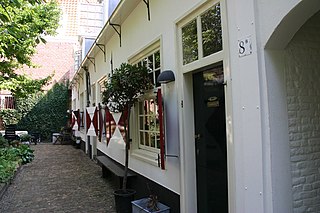
The Brouwershofje is a hofje on the Tuchthuisstraat in Haarlem, Netherlands.

The Hofje van Willem Heythuijsen is a hofje in Haarlem, Netherlands. It was founded in 1650 by the testament of Willem van Heythuysen on the site of his summer residence outside the city walls of Haarlem on land that was considered Heemstede property until it was annexed in 1927. It is one of the few hofjes of Haarlem to be built outside the city walls. It has a 'T' shape and has a small open courtyard and a garden still intact.

The Wijnbergshofje is a hofje in Haarlem, Netherlands, on the Barrevoetstraat.

The Zuiderhofje is a hofje in Haarlem, Netherlands.
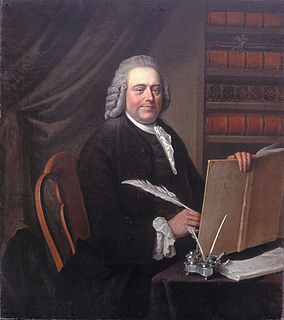
Pieter Teyler van der Hulst was a wealthy Dutch Mennonite merchant and banker, who died childless, leaving a legacy of two million florins to the pursuit of religion, arts and science in his hometown, that led to the formation of Teyler's Museum. This was not the value of his entire estate. He also founded Teylers Hofje in his name, and made important donations to individuals in the Mennonite community.

The Vrouwe- en Antonie Gasthuis is a hofje on the Klein Heiligland 64a in Haarlem, Netherlands. It is open on weekdays from 10-17.00.

Willem van Heythuysen, was a Dutch cloth merchant and hofje founder in Haarlem and Weert. He is best known today for his portraits by Frans Hals, though he is remembered locally for his Hofje van Willem Heythuijsen bordering Haarlemmerhout park, which has been in operation for centuries.

The Proveniershuis is a hofje and former schutterij on the Grote Houtstraat in Haarlem, Netherlands.

The Hofje van Codde en Beresteyn is a hofje in Haarlem, Netherlands. The current building is from 1968 and is located on the J. Cuyperstraat, which is named for the architect who designed the Cathedral of Saint Bavo next door, Joseph Cuypers. This hofje is the wealthiest hofje foundation in Haarlem with the most modern facilities for its inhabitants. Poor (devote) Catholic women of Haarlem 60 years and older are still welcome to live there for free.

Pieter Claesz Soutman was a Dutch Golden Age painter and printmaker from Haarlem.

The Hofje van Oorschot is a hofje on the Kruisstraat 44 in Haarlem, Netherlands.

The St. Elisabeth Gasthuis (EG) is a former hospital complex of buildings founded in 1581 in Haarlem on the Gasthuisvest. The last location of the hospital on the Boerhaavelaan retains its hospital function and is part of the Spaarne Gasthuis (SG) today, formerly known as Kennemer Gasthuis (KG). The hospital complex on the Gasthuisvest was built for the "Minnebroers" monastery and was reclaimed after the Protestant reformation in 1581 and given by the city council to the hospital. As a hospital during four centuries, the complex underwent many major renovations. The main facade dates from 1871.
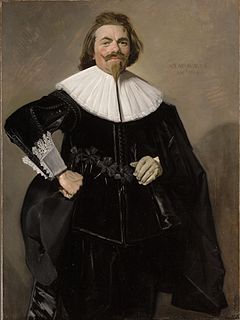
Tieleman Roosterman, was a Dutch cloth merchant and friend of Willem van Heythuysen. Roosterman is best remembered today for his portrait painted by Frans Hals.